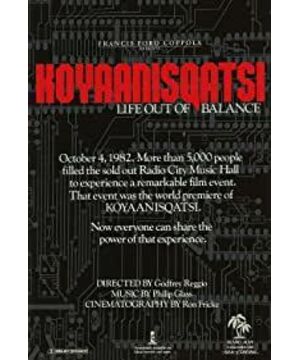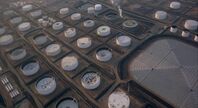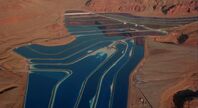This is a documentary that will be impacted differently every time you watch it. Just like the title of the film, the director uses a distinctive way of expression, non-narrative screen connections, no commentary, and no protagonist. The viewers experience the music and screen tape in such a world of unguided images. The impact to the soul is almost the impact of the end. Just like Kubrick's masterpiece "2001: A Space Odyssey", there are a large number of empty shots in the film, providing viewers with ample room for imagination. A large number of visually impactful images seem to be deliberately intended by the director to allow viewers to enjoy the "appearances" displayed. These "appearances" bring the viewers' perceptual knowledge into a systematic spiritual experience at the end of the film; The noises and spell-like music that fill the ears surround the viewer like a ghost, creating unspeakable depression and entanglement. The first impression of such a focus on sound and painting, I think this may be a style Works that tend to be sentimental movies. And such perceptual works carry too many religious images, which are subtly implanted in the spiritual world of the viewers in the dark.
This stunning work that took 7 years, the title "Koyaanisqatsi" is from the Indian language, which has the meaning of madness, chaos, loss of balance, collapse and alternative life. As old and mysterious as the title, there is also the opening paragraph: when the red title subtitles gradually fade away, a head-up shot of ancient rock murals slowly opened appears in the faded-in picture, when the viewer is still wondering the meaning of the mural , The explosion picture overlapped it, the fire quickly filled the frame and flooded the mural, the spokesperson of the ancient civilization turned into the slowly falling debris and dust in the next shot, as well as the slow motion of the mechanical movement shown in the background. The picture of this passage ends with the music. As the spell-like singing in the music fades away, the bottom-up fire and denser smoke in the picture flock around the frame, and the picture gradually becomes blank. Switch to the next paragraph. This 3-minute opening paragraph can only be understood in depth after watching the entire film and understanding the meaning of the film’s soundtrack: on the one hand, the opening image is a visual presentation of the film’s music, and it was also a Catholic priest. The director's worldview and the metaphor of ecological philosophy. The creator of the film’s music, Philip Glass, is a representative of minimalist modern music. His soundtrack runs through the film. Prophecies)’s prophetic song. The lyrics are written in the Hebi dialect. The translation is: "If we dig out precious things from the ground, we invite disaster. When the day of purification comes, the sky is intertwined. Cobwebs. A container filled with ashes will one day pour out from the sky, burning the earth and boiling the ocean.” As the chant like this spell says, the opening is exactly when post-human civilization severely destroyed the natural ecological environment. The symbolic picture when the disaster comes, the flame engulfed the ancient civilization, and also took away the smug post-modern industrial civilization of mankind, and everything was reduced to zero. On the other hand, the correspondence between the beginning and the end makes the film not only complete, but also gives this repetitive paragraph richer connotations. The end of the film also uses the male chorus of "Hepi prophecy", but the screen presents the data image of the Columbia rocket launched by the United States. Surrounded by the spell, the rocket turns from rising to falling. The center of the lens rotates and falls to the right, until the close-up shot is slowly switched, the picture fades out and cuts into a picture similar to the schist rock mural, and the film ends. Contacting the entire content of the film, the rocket that represents the achievements of postmodern science and technology exploded and fell. It is the prediction that people under postmodern civilization will one day play with fire and set themselves on fire if they blindly abuse technological means and ignore the ecological balance. In addition, the rock murals at the end of the movie seem to imply the director's views on modern people's religious beliefs. A careful comparison of the opening and closing murals shows that the former seems to be a god worshiped by ancient humans, while the latter is a rock wall occupied by many gods. This may be what the director found in the "Hepi prophecy". Inspiration, if the prophecy of the spell is fulfilled, disasters really come, mankind really perishes, and gods will occupy the world again. Such an outcome may be the best way to save the "life out of balance".
In addition to doomsday prophecies, there are many images related to religion, gods, and prophecies in the film. Aside from the metaphorical passages at the beginning and the end of the film, the film can be roughly divided into two parts: the first part, which expresses natural scenery; the second part, which expresses the post-modern life of mankind.
As mentioned above, the first part shows natural scenery. From a religious perspective, it seems to be a demonstration of the process by which God created mankind.
(1) Before life appears. From 00:03:45 to 00:11:05, the screen mainly presents a vast rocky landscape (inlaid with desert geology). The director used this series of shots to create a primitive world without any trace of life. The grand vision under aerial photography makes the scenery more turbulent. Everything is calm and natural, and it can even be called a "life in balance"; Philip Glass The soundtrack draws lessons from the "circular rhythm structure" in Indian music and applies the principle of repetition extensively. While repeating the whole song with a simple sound pattern, it expands the rhythm and enhances the orchestration effect, etc. to make it change. This kind of sacred and mysterious effect, so far, an image of "before life appears" stands out. But under the combined action of bare rocks, dry light and shadow effects, similar scenes, tones, and repeated simple melodies, the viewers will feel a sense of loneliness, monotony, and lack in the hearts of the viewers. The lifeless world makes people slow. Slowly becomes anxious, maybe God created life because of this?
(2) God created life and laid down the rules of human existence. At the end of (1), the rocks in the lens are shrouded in the shadow of clouds, and the shadow of the cloud movement under the lens is getting bigger and bigger, which seems to herald the arrival of the moment of great changes in the world. Later at 00:11:09, a close-up shot of a rock illuminated by the sun was cut into the picture, and insects kept flying by in front of the camera. This was the first time life other than plants appeared in this film. The caves, clouds, ocean, sunlight and other sceneries that appeared after this are the conditions for life to multiply. Because they have not been destroyed by humans, they are so magnificent and sacred in the picture. They are gifts from God to mankind. The human picture at the back of the film, this part can be said to be the most beautiful passage in the whole film, which also implies that human beings are destroying the ecology, which is essentially a chronic suicide. But I still have another idea that if the picture and the meaning of the music are closely linked, perhaps this passage is a visualized "Hebi prophecy." At the 11th minute, the male chorus floated out of the picture again. At this time, the cave in the picture seemed to be a metaphor for people digging out precious things from the ground. With the light beam outside the cave extinguished, the disaster we invited came. Then there appeared inverted clouds in the picture, and due to the different light and shadow effects, the clouds were gray-black, which are the spider webs intertwined in the sky on the day of purification. A quick shot of the white clouds rushing, the waterfall under the rapid slope is similar to the picture in the lyrics of "a container with ashes will pour out of the sky one day", and "will burn the earth and boil the ocean" is afterwards In the ocean scene that appeared, the shimmering sea seemed to be boiling due to the reflection of light. With the extremely sharp orchestral collaboration, the huge waves rolled freely in front of the camera, and the clouds and mist rolled over the mountains and rivers. So far, the "Hebi people's prophecy" was vividly and implicitly portrayed by the director. Perhaps this is a reasonable conjecture of the director. Before the creation of mankind, God set this rule of survival in order to ensure the balanced development of man and the ecological environment. When mankind violates it, God will take back the conditions on which mankind lives and use the predicted disaster as punishment.
(3) The emergence of human beings. At the 16th minute and 18th, a beam of light appeared in the middle of the screen, and the rhythm of the background music also began to accelerate, as if it was heralding that something new was coming. The camera suddenly speeds up and moves forward quickly, passing mountains and rivers. The low-flying camera seems to be looking for it. Until 00:17:10, colorful ground appears in the lens. If you can compare these beautiful scenery to the Garden of Eden, Adam And Eve will definitely appear here, then human beings are their descendants. The lens of looking for this is to recognize the ancestors and return to the ancestors, and it also indicates that humans are about to appear. Sure enough, after passing the stone that had appeared at the beginning of the article, humans appeared, but it was ironically replaced by a scene of blasting. Blasting is a visual expression of birth. It makes the picture dynamic, but it also makes the scene of destruction and imbalance become the protagonist of the film. In connection with the explosion screen at the end of the movie, fatalists will definitely say that human beings were born in blasting and will die in blasting.
When humans appeared and the previous part of the film ended, a visual passage full of religious significance was replaced by mechanical images brought about by post-modern civilization, but in these images, the director also has embedded symbolic shots.
Mushroom Cloud-God of Death
When human beings are immersed in the joy of post-industrial civilization, the images of the atomic bomb explosion are always full of subjective colors of worship. We have been shocked by the spectacular fire more than once, but the feelings we get in "Life Lost Balance" are quite the opposite. From 22 minutes and 10 seconds, two atomic bomb explosions appeared in the film. The continuous explosion made the second mushroom cloud no longer feel fresh, and the dead branches on the left side of the foreground created a different feeling for this shot. : Before the explosion, the dead branches attracted attention; after the explosion, the fire and gray black smoke continued to rise, reaching the same height as the dead branches, until they were far above it. At this time, the dead branches became surprisingly small, as if hiding under the dead branches. The people of the atomic bomb are even more oppressive. The mushroom cloud always stretches its teeth and claws behind the dead branches. From a standard mushroom shape, it becomes more and more like a giant wearing a black robe. The raging posture, plus the metal sound effect in the ear, A sense of danger arises spontaneously, and it has to be reminiscent that the person standing in front of him is not a giant, but the god of death who brought doomsday. Back to reality, this kind of association is so reasonable and ingenious. The invention of the atomic bomb has brought about the modernization of war, and the modernization of war has brought about unprecedented mass killings. How many people’s doomsday is in this explosion. Coming!
The director Godfrey Reggio used to be a Catholic priest. In his film, I saw a kind of release of the soul. Perhaps he thinks that a devout believer does not need to use words to pray to God. He wants to use light and shadow. Holy music preached to the children of God and preached to people without faith. And he believes that protecting ecological balance is the doctrine that humans should understand most today. Therefore, there is a silent warning record like "Life Losing Balance" in the world.
View more about Koyaanisqatsi reviews











